

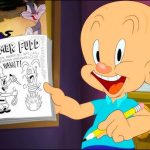

So where has animation gone in terms of self-reference to the art and the industry in recent years? While it seems that specific references to the medium have been overall fewer in number comparative to the amount of product produced, there have still been some memorable moments, including not only for the small screen, but in theatrical short and feature-length formats. Some are indeed better than others, but it is fun that the revival in interest of the public and devoted fans for classic animation has virtually brought some of the most recent productions full circle, with nostalgic looks back at animation’s distant past, and even the classic Looney Tunes again returning to take up pencil and paper at the drawing board. Animation has survived as an art form well over a century, and remains enough of a viable commodity that it can still fascinate us with wonderment, inspire creative writing and visual innovation, and generally support itself to boot. Not a bad legacy, eh, doc?
 Virtual Tex (DIC, The Wacky World of Tex Avery, 10/20/97) finds Tex Avery (the cowboy hero, not the animator) traveling a canyon trail aboard his faithful steed, Burrito the goat, attempting to track his arch-enemy Sid, who has once again kidnapped Tex’s would-be girl, Miss Chastity. They approach a fork in the trail with two road signs, one pointing to a destiation of “Bliss”, the other to “Doom”. Suddenly Burrito stops cold at the junction, though Avery didn’t tell him to whoa. Burrito steps out of character, stands up (throwing Tex), and addresses in human speech the viewing audience. “Ladies and Gentlemen. The producers have decoded to update this old-fashioned plot by turning our episode into an interactive adventure. At pivotal points in the action, you will be asked to make a choice, such as, do you wish us to take the easy path through Blissful Meadows, or the dreaded peril of Doom Valley?” Burrito explains that buttons have been provided to the viewers to register their choices via on-screen score meters. Burrito then returns to his “unfulfilling tole as a speechless pack animal.” Tex refers to this as “high-tech gobbledy-goop”, and is shocked when the first score registers, sending them to Doom Valley by a vote of 18,732 to 3. “I hope you folks know what you’re a-gettin’ me into.” We soon do, as a montage of shots shows Tex pursued by a horror-movie sized scorpion, an equally king-sized rattlesnake, and then found half-buried in a sand dune. “Freedom of choice is overrated”, says Tex.
Virtual Tex (DIC, The Wacky World of Tex Avery, 10/20/97) finds Tex Avery (the cowboy hero, not the animator) traveling a canyon trail aboard his faithful steed, Burrito the goat, attempting to track his arch-enemy Sid, who has once again kidnapped Tex’s would-be girl, Miss Chastity. They approach a fork in the trail with two road signs, one pointing to a destiation of “Bliss”, the other to “Doom”. Suddenly Burrito stops cold at the junction, though Avery didn’t tell him to whoa. Burrito steps out of character, stands up (throwing Tex), and addresses in human speech the viewing audience. “Ladies and Gentlemen. The producers have decoded to update this old-fashioned plot by turning our episode into an interactive adventure. At pivotal points in the action, you will be asked to make a choice, such as, do you wish us to take the easy path through Blissful Meadows, or the dreaded peril of Doom Valley?” Burrito explains that buttons have been provided to the viewers to register their choices via on-screen score meters. Burrito then returns to his “unfulfilling tole as a speechless pack animal.” Tex refers to this as “high-tech gobbledy-goop”, and is shocked when the first score registers, sending them to Doom Valley by a vote of 18,732 to 3. “I hope you folks know what you’re a-gettin’ me into.” We soon do, as a montage of shots shows Tex pursued by a horror-movie sized scorpion, an equally king-sized rattlesnake, and then found half-buried in a sand dune. “Freedom of choice is overrated”, says Tex.
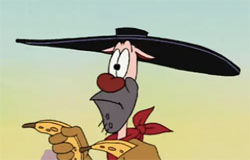 More votes keep coming in, each one as lopsided as the first in favor of the selection that seems the least conducive to Tex’s safety. Tex asks if the viewers got up on the wronh side of the bed this morning. A biker mob roars across the desert, lassoing Tex by the feet and dragging him across the sands. In a Western town, Tex is stalked b a drooling homicidal blacksmith with twin sledge hammers. Tex ducks in a shed, only to find inside an assembly line replete with robotic boxing gloves, chomping false teeth, chainsaws, mallets, and other brutal devices. He and Burrito are ejected by the machinery’s blows into the center of an angry mob, armed with cannon. After a mauling, they take refuge in another shed, where Tex asks the audience, “I like a joke as much as the next guy, but COME ON!” The latest vote makes the shed a dynamite shack, blowing out heroes sky high. “Try to be a nice guy”, mutters Tex. Another vote, and they land in a large pile of manure. Now Tex knows there’s something fishy, as no audience would do that to their hero. Tex pulls out a cell phone and calls his mother, asking if she’s been watching his cartoon at the old folks’ ranch. She responds yes, and says everyone’s been voting for Tex, but the votes aren’t registering on the screen. Tex knows this is Sid’s work – and at his hideout, Sid watches Tex on his television, button controller in hand, using sophisticated signal-jamming to block the real votes. Sid gloats to Chastity that Tex will never find him – but Tex does so in an instant, stepping right out of the television screen. Tex also mentions that tracking Sid was a snap, since his cabin was located right next to the manure pile, and surrounded by giant sattelite dishes. Chastity is freed, and asks if Tex intends to toss Sid in the hoosegow. “I don’t think so”, says Tex, with a vengeful grin. A fade, and we see Sid in the same town where we previously saw Tex, dragged in by the bikers, attacked by a giant rat, pursued by a tank, having a safe dropped on him, stampeded by wild elephants, grabbed by a dinosaur and inflated by his breath into the shape of a balloon, floating into space to get struck by a hit-and-run flying saucer, falling into Hades’ flame as a crack in the Earth opens beneath him, and finally clobbered by the homicidal blacksmith’s hammers – each fate accompanied by on-screen votes registering a choice of a glowing skull-and-crossbones option. At his TV set sits Tex, pushing the buttons of a controller to select Sid’s fate. “Maybe there’s something to this interactive sheep dip after all.” Chastity appears, stating that Tex still hasn’t received his reward, puckering up for a kiss. But a vote meter appears on the screen, selecting another option, and Chastity merely gives him a handshake. “Now that was cold”, says Avery to the audience, wondering who made that selection. The camera returns to the manure pile, where Burrito, selector button in hand, snickers.
More votes keep coming in, each one as lopsided as the first in favor of the selection that seems the least conducive to Tex’s safety. Tex asks if the viewers got up on the wronh side of the bed this morning. A biker mob roars across the desert, lassoing Tex by the feet and dragging him across the sands. In a Western town, Tex is stalked b a drooling homicidal blacksmith with twin sledge hammers. Tex ducks in a shed, only to find inside an assembly line replete with robotic boxing gloves, chomping false teeth, chainsaws, mallets, and other brutal devices. He and Burrito are ejected by the machinery’s blows into the center of an angry mob, armed with cannon. After a mauling, they take refuge in another shed, where Tex asks the audience, “I like a joke as much as the next guy, but COME ON!” The latest vote makes the shed a dynamite shack, blowing out heroes sky high. “Try to be a nice guy”, mutters Tex. Another vote, and they land in a large pile of manure. Now Tex knows there’s something fishy, as no audience would do that to their hero. Tex pulls out a cell phone and calls his mother, asking if she’s been watching his cartoon at the old folks’ ranch. She responds yes, and says everyone’s been voting for Tex, but the votes aren’t registering on the screen. Tex knows this is Sid’s work – and at his hideout, Sid watches Tex on his television, button controller in hand, using sophisticated signal-jamming to block the real votes. Sid gloats to Chastity that Tex will never find him – but Tex does so in an instant, stepping right out of the television screen. Tex also mentions that tracking Sid was a snap, since his cabin was located right next to the manure pile, and surrounded by giant sattelite dishes. Chastity is freed, and asks if Tex intends to toss Sid in the hoosegow. “I don’t think so”, says Tex, with a vengeful grin. A fade, and we see Sid in the same town where we previously saw Tex, dragged in by the bikers, attacked by a giant rat, pursued by a tank, having a safe dropped on him, stampeded by wild elephants, grabbed by a dinosaur and inflated by his breath into the shape of a balloon, floating into space to get struck by a hit-and-run flying saucer, falling into Hades’ flame as a crack in the Earth opens beneath him, and finally clobbered by the homicidal blacksmith’s hammers – each fate accompanied by on-screen votes registering a choice of a glowing skull-and-crossbones option. At his TV set sits Tex, pushing the buttons of a controller to select Sid’s fate. “Maybe there’s something to this interactive sheep dip after all.” Chastity appears, stating that Tex still hasn’t received his reward, puckering up for a kiss. But a vote meter appears on the screen, selecting another option, and Chastity merely gives him a handshake. “Now that was cold”, says Avery to the audience, wondering who made that selection. The camera returns to the manure pile, where Burrito, selector button in hand, snickers.
• “Virtual Tex” is watchable on DailyMotion.
 Superior Duck (Chuck Jones Productions/Warner, Daffy Duck, 8/23/98 – Chuck Jones, dir.) – One of Jones’s often irregular, self-produced comeback efforts for the studio late in life – and this one’s a bit more irregular than usual. For one thing, it was produced at a transitional point when Jones preferred to use Frank Gorshen as primary voice. Gorshen’s Daffy takes a bit of getting used to, and really only comes somewhat close in the under-the-breath muttering mode. For another thing, this episode might have fared better if there had actually been a plot written for it. Jones self-penned the project without the assistance of Michael Maltese, and seems to have settled on accomplishing nothing more in six minutes than parodying the same standard intro to Superman cartoons that it took him only about a minute and a half to accomplish to greater effect in “Super-Rabbit” 55 years earlier.
Superior Duck (Chuck Jones Productions/Warner, Daffy Duck, 8/23/98 – Chuck Jones, dir.) – One of Jones’s often irregular, self-produced comeback efforts for the studio late in life – and this one’s a bit more irregular than usual. For one thing, it was produced at a transitional point when Jones preferred to use Frank Gorshen as primary voice. Gorshen’s Daffy takes a bit of getting used to, and really only comes somewhat close in the under-the-breath muttering mode. For another thing, this episode might have fared better if there had actually been a plot written for it. Jones self-penned the project without the assistance of Michael Maltese, and seems to have settled on accomplishing nothing more in six minutes than parodying the same standard intro to Superman cartoons that it took him only about a minute and a half to accomplish to greater effect in “Super-Rabbit” 55 years earlier.
 Narrator Thurl Ravenscroft (voice of Tony the Tiger, with whom Jones had previously worked in presenting the song, “You’re a Mean One, Mr. Grinch”) sums up the whole thing best at the outset of the film, introducing Superior Duck as the “duck of yesterday” (while Daffy coaches him, “Tomorrow, The duck of tomorrow!”) Even Daffy’s outfit looks like yesterday – a sort of rumpled version of his old Duck Dodgers suit, with a yellow exclamation point insignia on his chest. The narrator starts into the usual spiel, with what an earlier Daffy might have called “noun trouble”. Superior Duck is “faster than a speeding snail”. “A speeding what?” reacts an irritated Daffy. Passing such a gastropod on a roof, the duck asks. “Are you suggesting that I’m only faster than a speeding – – that?” As he makes derogatory comments upon the slug’s ability to shift from zero to 60 inches, the snail suddenly revs up its tail like an outboard motor, and zips out of frame at super speed, spinning Daffy around and making his beak fall off. “I could be wrong, you know”, says Daffy’s detached beak. As another larger character streaks by Daffy, largely unseen, Daffy says, “It’s about time”, and outraces it, as the narrator changes his line to “faster than a speeding pullet.” It is, in fact, a small chicken. Daffy tries to get the narrator to straighten it out to “bullet”, but is interrupted by a cameo from Foghorn Leghorn, who rises to the defense of the chicken. He refers to Daffy as a gander, until Daffy states he is the illustrious Superior Duck. “I just wonder if you can superior duck – this!”, says Foghorn, laying a blow to Daffy’s bill with the visible word, “Ka-Pow!” Daffy is again forced to reattach his bill.
Narrator Thurl Ravenscroft (voice of Tony the Tiger, with whom Jones had previously worked in presenting the song, “You’re a Mean One, Mr. Grinch”) sums up the whole thing best at the outset of the film, introducing Superior Duck as the “duck of yesterday” (while Daffy coaches him, “Tomorrow, The duck of tomorrow!”) Even Daffy’s outfit looks like yesterday – a sort of rumpled version of his old Duck Dodgers suit, with a yellow exclamation point insignia on his chest. The narrator starts into the usual spiel, with what an earlier Daffy might have called “noun trouble”. Superior Duck is “faster than a speeding snail”. “A speeding what?” reacts an irritated Daffy. Passing such a gastropod on a roof, the duck asks. “Are you suggesting that I’m only faster than a speeding – – that?” As he makes derogatory comments upon the slug’s ability to shift from zero to 60 inches, the snail suddenly revs up its tail like an outboard motor, and zips out of frame at super speed, spinning Daffy around and making his beak fall off. “I could be wrong, you know”, says Daffy’s detached beak. As another larger character streaks by Daffy, largely unseen, Daffy says, “It’s about time”, and outraces it, as the narrator changes his line to “faster than a speeding pullet.” It is, in fact, a small chicken. Daffy tries to get the narrator to straighten it out to “bullet”, but is interrupted by a cameo from Foghorn Leghorn, who rises to the defense of the chicken. He refers to Daffy as a gander, until Daffy states he is the illustrious Superior Duck. “I just wonder if you can superior duck – this!”, says Foghorn, laying a blow to Daffy’s bill with the visible word, “Ka-Pow!” Daffy is again forced to reattach his bill.
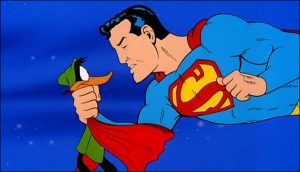 Daffy soliloquizes why he ever got into the animation business anyway, speculating how he might have made out providing supply for duck down pillows, when the narrator reminds him he hasn’t done the “more powerful” bit. “Get lost, Jack”, says Daffy. “No work, no pay”, says the narrator. Daffy freezes, reverses course, and returns to his duties, muttering, “If it wasn’t for avarice, for sheer greed, I’d be a very happy duck.” He stands upon a railroad track, and braces to hold back the approach of the headlight of an oncoming locomotive. The headlight turns out to be considerably smaller than expected – attached to a miniature toy locomotive controlled by Tweety, who passes between Daffy’s feet, commenting, “I did taw an upside-downy putty duck.” Several other cameos randomly fill out the remaining time, including the Road Runner and Wile E. Coyote (the latter encountering Daffy after the Road Runner has flattened him, and holding up a sign reading, “Well – Better a duck dinner than nothing at all.”), Marvin Martian and space-cadet Porky Pig (reprising for no good reason the disintegration/re-integration pistol gag from “Duck Dodgers of the 24 1/2th Century”), and the Tasmanian Devil. Daffy finally settles down to his own self-narration and to concentrate on saving the human race, when a large human hand seizes him by the throat and drags him upward out of frame. The hand belongs to the real Superman, in his only crossover into a Looney Tune, who informs Daffy, “I’m working this side of the street. Now bug off!” Daffy does just that, making a costume change to one with insect wings, bee stripes, and a stinger, as “Superior Bug”. In the last shot, as the narrator ad-libs new “faster than” and “more powerful than” lines, Daffy demonstrates his flying prowess, by regularly bumping into tall buildings, causing lighted signs on them to register “Tilt”.
Daffy soliloquizes why he ever got into the animation business anyway, speculating how he might have made out providing supply for duck down pillows, when the narrator reminds him he hasn’t done the “more powerful” bit. “Get lost, Jack”, says Daffy. “No work, no pay”, says the narrator. Daffy freezes, reverses course, and returns to his duties, muttering, “If it wasn’t for avarice, for sheer greed, I’d be a very happy duck.” He stands upon a railroad track, and braces to hold back the approach of the headlight of an oncoming locomotive. The headlight turns out to be considerably smaller than expected – attached to a miniature toy locomotive controlled by Tweety, who passes between Daffy’s feet, commenting, “I did taw an upside-downy putty duck.” Several other cameos randomly fill out the remaining time, including the Road Runner and Wile E. Coyote (the latter encountering Daffy after the Road Runner has flattened him, and holding up a sign reading, “Well – Better a duck dinner than nothing at all.”), Marvin Martian and space-cadet Porky Pig (reprising for no good reason the disintegration/re-integration pistol gag from “Duck Dodgers of the 24 1/2th Century”), and the Tasmanian Devil. Daffy finally settles down to his own self-narration and to concentrate on saving the human race, when a large human hand seizes him by the throat and drags him upward out of frame. The hand belongs to the real Superman, in his only crossover into a Looney Tune, who informs Daffy, “I’m working this side of the street. Now bug off!” Daffy does just that, making a costume change to one with insect wings, bee stripes, and a stinger, as “Superior Bug”. In the last shot, as the narrator ad-libs new “faster than” and “more powerful than” lines, Daffy demonstrates his flying prowess, by regularly bumping into tall buildings, causing lighted signs on them to register “Tilt”.
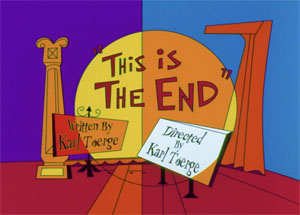 This Is The End, the final episode of Warner’s “Sylvester and Tweety Mysteries” (12/18/02) has no mystery to solve. Instead, it answers an age-old question, held in common with the coyote/road-runner pursuit. What would happen if Sylvester ever did eat Tweety? On this day, Sylvester has the “eye of the tiger’ and pursues Tweety relentlessly. Hector the bulldog is put out of action by a collision headfirst into a wall, knocking him cold. Tweety, tiring, nevertheless stands his ground, reminding the putty that he could never actually eat him, as they wouldn’t have a show, Tweety being the star. Sylvester won’t take no for an answer – and finally grabs, chews, and swallows our canary, remarking that that star could have used a little salt, and tastes like chicken. When Granny discovers the fowl deed, she phones in the sad news to the network, and receives the response she expected. The show is immediately cancelled. But wait – a savvy Warner female executive thinks there’s more profit in reviving the show with a new star. Accounting claims they can absorb the losses – as they’re pretty sure they’ve over-budgeted every other show. Sylvester, in orange prison attire for his crime, is granted special reprive to appear at the studio to film new episodes. But who will be the new star? A talent search is held in open auditions, with every past Warner avian in line for a tryout – plus Cool Cat, in his obligatory cameo featured in every series episode. Finally, a new star is unveiled – a cherubic-faced canary with overly-rotund features and a basso voice. The viewers are not taken in, and a massive public outcry against the new character rises around the world. It gets so nobody will watch TV anymore – even kindergarten classes, where the kids instead take up healthy and constructive activities. World stock markets plunge, as merchandising rights disintegrate. The Warner executive sums it up to a world council in four words – “No Tweety, no profits.” Even the other prisoners in the slammer with Sylvester turn on the cat, complaining that there’s no funny cartoons on to watch anymore. Angry mobs rise in the street, and even the military (led by a George C. Scott-like general in a command tank) launch an attack to make the pussy-cat pay. The general promises Sylvester will be the new seat cushion in his tank. As one of the prisoners busts out of jail, using Sylvester as his excavation shovel for tunneling, the mobs and the army converge on the spot. All hands grab at Sylvester, trying to pull him apart, while the General complains that they’re wrinkling his seat cushion. In a swirling scene transition, our view returns to Granny’s living room, where Sylvester nervously twitches on the floor – in the middle of a bad dream. The very-much-alive Tweety enters with a bucket of water, stating he’s always wanted the chance to do this, and drenches Sylvester to awaken him. Though Sylvester is initially overjoyed to see Tweety alive, a carnivorous look appears on his face as he notices they are alone, and once again, the cat grabs up Tweety in his paw. “Don’t do it, putty”, begs Tweety. A pause – and to our surprise, Sylvester grips Tweety in a two-armed embrace to his chest. “I love ya, buddy. You’re the best.” Tweety can only remark to the audience. “See why cartoons are so special? Anything can happen.”
This Is The End, the final episode of Warner’s “Sylvester and Tweety Mysteries” (12/18/02) has no mystery to solve. Instead, it answers an age-old question, held in common with the coyote/road-runner pursuit. What would happen if Sylvester ever did eat Tweety? On this day, Sylvester has the “eye of the tiger’ and pursues Tweety relentlessly. Hector the bulldog is put out of action by a collision headfirst into a wall, knocking him cold. Tweety, tiring, nevertheless stands his ground, reminding the putty that he could never actually eat him, as they wouldn’t have a show, Tweety being the star. Sylvester won’t take no for an answer – and finally grabs, chews, and swallows our canary, remarking that that star could have used a little salt, and tastes like chicken. When Granny discovers the fowl deed, she phones in the sad news to the network, and receives the response she expected. The show is immediately cancelled. But wait – a savvy Warner female executive thinks there’s more profit in reviving the show with a new star. Accounting claims they can absorb the losses – as they’re pretty sure they’ve over-budgeted every other show. Sylvester, in orange prison attire for his crime, is granted special reprive to appear at the studio to film new episodes. But who will be the new star? A talent search is held in open auditions, with every past Warner avian in line for a tryout – plus Cool Cat, in his obligatory cameo featured in every series episode. Finally, a new star is unveiled – a cherubic-faced canary with overly-rotund features and a basso voice. The viewers are not taken in, and a massive public outcry against the new character rises around the world. It gets so nobody will watch TV anymore – even kindergarten classes, where the kids instead take up healthy and constructive activities. World stock markets plunge, as merchandising rights disintegrate. The Warner executive sums it up to a world council in four words – “No Tweety, no profits.” Even the other prisoners in the slammer with Sylvester turn on the cat, complaining that there’s no funny cartoons on to watch anymore. Angry mobs rise in the street, and even the military (led by a George C. Scott-like general in a command tank) launch an attack to make the pussy-cat pay. The general promises Sylvester will be the new seat cushion in his tank. As one of the prisoners busts out of jail, using Sylvester as his excavation shovel for tunneling, the mobs and the army converge on the spot. All hands grab at Sylvester, trying to pull him apart, while the General complains that they’re wrinkling his seat cushion. In a swirling scene transition, our view returns to Granny’s living room, where Sylvester nervously twitches on the floor – in the middle of a bad dream. The very-much-alive Tweety enters with a bucket of water, stating he’s always wanted the chance to do this, and drenches Sylvester to awaken him. Though Sylvester is initially overjoyed to see Tweety alive, a carnivorous look appears on his face as he notices they are alone, and once again, the cat grabs up Tweety in his paw. “Don’t do it, putty”, begs Tweety. A pause – and to our surprise, Sylvester grips Tweety in a two-armed embrace to his chest. “I love ya, buddy. You’re the best.” Tweety can only remark to the audience. “See why cartoons are so special? Anything can happen.”
• “This Is The End” is on the Internet Archive.
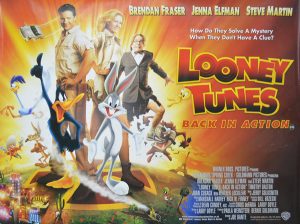 Making up for the disappointing Space Jam, Warner finally gave the public what they wanted, in a quality spoof of Roger Rabbit entitled Looney Tunes: Back in Action (11/9/03). Here, the Looney Tunes take center stage, not about to be pushed aside by their live-action co-stars. And, there is actually some degree of a serviceable plot, providing more than enough of a framework to support a feature-length dose of golden-level buffoonery, movie homages, industry in-jokes, and cameos from toons we haven’t seen outside a handful of appearances in the classic shorts. However, the public in large part didn’t seem to notice, and the film suffered an overall box-office loss. Perhaps, with a full production budget rather than the minimal finances needed to produce feature-length cheaters incorporating old cartoons such as: The Looney, Looney Bugs Bunny Movie, Daffy Duck’s Fantastic Island, etc., the public, with so much old Looney footage thick on the ground for free on TV or on video, wasn’t willing to lend its financial support to the Bugs Bunny gang on the big screen without a massive drawing card for a live-action co-star. Brenden Fraser and Steve Martin weren’t enough to make this production financially viable. (The same phenomenon has just been experienced this season, with the disappointing receipts of the recent “The Day the Earth Blew Up”.) It indeed seems to have been only the basketball crowd that supported “Space Jam”, and without it, Looney Tunes don’t seem to make it on the big screen. Yet, for those of us who did go to see the picture, I found a first-week audience with its laugh reflexes set on a “hare” trigger, and every gag seemed to develop a deserved roar. I also recall having to visit the rest room after the performance, to place cold water upon my jaw muscles, which were literally aching from the frequent laughter I had emitted during the screening – a phenomenon I cannot recall experiencing for any other picture.
Making up for the disappointing Space Jam, Warner finally gave the public what they wanted, in a quality spoof of Roger Rabbit entitled Looney Tunes: Back in Action (11/9/03). Here, the Looney Tunes take center stage, not about to be pushed aside by their live-action co-stars. And, there is actually some degree of a serviceable plot, providing more than enough of a framework to support a feature-length dose of golden-level buffoonery, movie homages, industry in-jokes, and cameos from toons we haven’t seen outside a handful of appearances in the classic shorts. However, the public in large part didn’t seem to notice, and the film suffered an overall box-office loss. Perhaps, with a full production budget rather than the minimal finances needed to produce feature-length cheaters incorporating old cartoons such as: The Looney, Looney Bugs Bunny Movie, Daffy Duck’s Fantastic Island, etc., the public, with so much old Looney footage thick on the ground for free on TV or on video, wasn’t willing to lend its financial support to the Bugs Bunny gang on the big screen without a massive drawing card for a live-action co-star. Brenden Fraser and Steve Martin weren’t enough to make this production financially viable. (The same phenomenon has just been experienced this season, with the disappointing receipts of the recent “The Day the Earth Blew Up”.) It indeed seems to have been only the basketball crowd that supported “Space Jam”, and without it, Looney Tunes don’t seem to make it on the big screen. Yet, for those of us who did go to see the picture, I found a first-week audience with its laugh reflexes set on a “hare” trigger, and every gag seemed to develop a deserved roar. I also recall having to visit the rest room after the performance, to place cold water upon my jaw muscles, which were literally aching from the frequent laughter I had emitted during the screening – a phenomenon I cannot recall experiencing for any other picture.
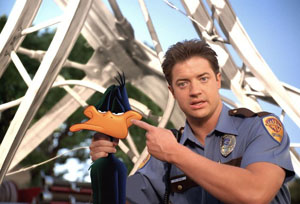 We begin with what appears to be another installment in Chuck Jones’ “Rabbit Season” trilogy, with the usual debate of seasons going on between Bugs and Daffy, and Elmer blowing Daffy’s bill off at every opportunity. The scene cuts from the action to the executive board room of two persona-less studio moguls who take on the roles of Warner’s illustrious brothers, where Daffy is shouting his head off, complaining about the latest script we have just seen depicted, with every page including the duck getting blasted. Bugs, getting the V.I.P. treatment from the staff, sits in a comfortable chair, taking the whole thing in stride as just a typical day at the office. A new female executive Vice President of Comedy (Jenna Elfman) presents Daffy with demographic studies indicating ducks are down, rabbits are in – and gets Daffy fired (though the duck insists as he is led away that he isn’t finished groveling). Bugs continues to take the events lightly, figuring Daffy will be back on payroll before they know it, but things don’t work out so smoothly, as a mishap with studio security guard Brenden Fraser (son of one of the studio’s top stars in secret agent films, but aspiring to prove himself on his own worth as a stunt man) damages the Batmobile and brings down the famous studio water tower. Both Fraser and Daffy are booted off the lot.
We begin with what appears to be another installment in Chuck Jones’ “Rabbit Season” trilogy, with the usual debate of seasons going on between Bugs and Daffy, and Elmer blowing Daffy’s bill off at every opportunity. The scene cuts from the action to the executive board room of two persona-less studio moguls who take on the roles of Warner’s illustrious brothers, where Daffy is shouting his head off, complaining about the latest script we have just seen depicted, with every page including the duck getting blasted. Bugs, getting the V.I.P. treatment from the staff, sits in a comfortable chair, taking the whole thing in stride as just a typical day at the office. A new female executive Vice President of Comedy (Jenna Elfman) presents Daffy with demographic studies indicating ducks are down, rabbits are in – and gets Daffy fired (though the duck insists as he is led away that he isn’t finished groveling). Bugs continues to take the events lightly, figuring Daffy will be back on payroll before they know it, but things don’t work out so smoothly, as a mishap with studio security guard Brenden Fraser (son of one of the studio’s top stars in secret agent films, but aspiring to prove himself on his own worth as a stunt man) damages the Batmobile and brings down the famous studio water tower. Both Fraser and Daffy are booted off the lot.
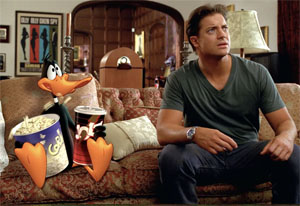 Daffy stows away, and winds up holing-up in Fraser’s home, despite every effort by Fraser to eject him bodily. Daffy discovers Fraser’s parentage, and reveals how he’s really into spy pictures. Suddenly, a surprise is revealed to Fraser, as a painting slides down within its frame on the wall, to reveal a TV screen. An image of Fraser’s dad is projected, seen fighting for his life. His father calls from the screen for help, indicating that he has a secret life beyond the big screen he did not want to involve his son in, and tells Fraser to find him in Las Vegas. Daffy smells a spy situation for real, and insists on joining Fraser in his motor trek to Vegas, in a beat-up car in the garage that Daffy is absolutely convinced is a spy car, because it doesn’t look anything like a spy car. As the vehicle pills out of the garage and the door closes, a panel in the pavement of the garage floor pivots 180 degrees, revealing a real cool spy car attached thereto, which out heroes missed.
Daffy stows away, and winds up holing-up in Fraser’s home, despite every effort by Fraser to eject him bodily. Daffy discovers Fraser’s parentage, and reveals how he’s really into spy pictures. Suddenly, a surprise is revealed to Fraser, as a painting slides down within its frame on the wall, to reveal a TV screen. An image of Fraser’s dad is projected, seen fighting for his life. His father calls from the screen for help, indicating that he has a secret life beyond the big screen he did not want to involve his son in, and tells Fraser to find him in Las Vegas. Daffy smells a spy situation for real, and insists on joining Fraser in his motor trek to Vegas, in a beat-up car in the garage that Daffy is absolutely convinced is a spy car, because it doesn’t look anything like a spy car. As the vehicle pills out of the garage and the door closes, a panel in the pavement of the garage floor pivots 180 degrees, revealing a real cool spy car attached thereto, which out heroes missed.
Back at the studio, Bugs is perplexed that Daffy has not been brought back, and endures a run-through of the latest script with only Elmer in support, in which the Rabbit Season/Duck Season bit just doesn’t work for two, and Bugs gets blasted. Elfman is given an ultimatum by the Warner Brothers – get Daffy back by Monday morning, or she’s fired. We cut away, also to be introduced to the board room of the powerful ACME Corporation, where chairman Steve Martin presides over a host of department-head flunkeys (V.P. Bad Ideas, V.P. Doesn’t Listen. Etc.). who chime in from time to time by being the first to hit game-show buzzers. They all keep careful watch by closed-circuit TV upon interrogation efforts taking place with Fraser’s father, having no success in getting him to talk. Martin seeks a priceless artifact known as The Blue Monkey – a huge diamond with mystical powers he hopes to use to take over the world.
 Elfman teams up with Bugs to find Daffy, the rabbit having by phone call to the duck has learned of Daffy’s quest to Vegas – but not before a memorable film homage, surprising Bugs in the shower, with a shot-for-shot lampoon of the famous scene from Hitchcock’s “Psycho”, climaxed by Bugs blinking an eye, and asking “Doesn’t anybody bother to knock?” Bugs and Elfman follow in the spy car left behind at Fraser’s home, with Bugs crooning “Viva Las Vegas” along the way. Bugs also checks out the car’s equipment, firing a missile out of the exhaust pipe, activating a martini maker that delivers Bugs a carrot-filled martini, shaken, not stirred, and finally an auto-valet that dresses him in tuxedo and Elfman in evening attire while they drive.
Elfman teams up with Bugs to find Daffy, the rabbit having by phone call to the duck has learned of Daffy’s quest to Vegas – but not before a memorable film homage, surprising Bugs in the shower, with a shot-for-shot lampoon of the famous scene from Hitchcock’s “Psycho”, climaxed by Bugs blinking an eye, and asking “Doesn’t anybody bother to knock?” Bugs and Elfman follow in the spy car left behind at Fraser’s home, with Bugs crooning “Viva Las Vegas” along the way. Bugs also checks out the car’s equipment, firing a missile out of the exhaust pipe, activating a martini maker that delivers Bugs a carrot-filled martini, shaken, not stirred, and finally an auto-valet that dresses him in tuxedo and Elfman in evening attire while they drive.
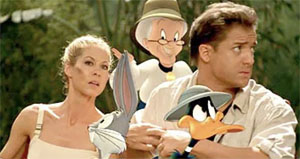 The search for Fraser’s dad and the Blue Monkey leads to a series of globe-trotting vignettes, in which several classic Looney Tunes are encountered among ACME’s employ. First, a stop at Yosemite Sam’s Wooden Nickel casino, resulting in a clue in the form of a mysterious playing card, and a wild car chase involving Yosemite and henchmen Nasty Canasta and Cottontail Smith. Fraser, Elfman, Bugs and Daffy join forces in the spy car, for a jet take-off over the desert, until Fraser crashes it with a wrong push of a button. Desert operative Wile E. Coyote tries his hand targeting out heroes with an ACME missile launcher, but as usual gets blasted himself. A Wal-Mart in the middle of nowhere provides some clever satire upon product placement, allowing our heroes to resupply themselves long enough to stumble upon the secret location of Area 52 (the real location of what the public thinks is Area 51), for an encounter with Marvin Martian and a bevy of space aliens, out to capture the playing card for ACME. The sequence includes several additional notable movie homages, including to “Invasion of the Body Snatchers” and a cameo for Robby the Robot from “Forbidden Planet”. Fraser also gets a tipoff as to the use of the playing card, and insight into ACME’s intent for use of the diamond. The diamond’s power – to transform humans into monkeys, and back again. ACME wants to use monkeys as cheap labor to manufacture their products, then turn them back into humans to purchase them. On to France (via a simple flip of a background by Bugs), and a whirl in the Louvre Museum, using a window overlay in the card to find what is behind Mona Lisa’s smile – a secret map to the diamond’s location in Africa Along the way, we get more salutes to various art forms, via a painting-hopping chase with Elmer Fudd, similar to Darkwing Duck’s “Brush with Oblivion”, including visits to Dali’s world of melted watches (also melting Elmer’s gun barrel), The Scream, Toulouse Lautrec’s poster world of Can Can dancers (Bugs and Daffy), and Georges Saurat’s pointilism (allowing Bugs to blow the transformed Elmer away with an electric fan, while Elmer can only comment, “Oh, Cwud”).
The search for Fraser’s dad and the Blue Monkey leads to a series of globe-trotting vignettes, in which several classic Looney Tunes are encountered among ACME’s employ. First, a stop at Yosemite Sam’s Wooden Nickel casino, resulting in a clue in the form of a mysterious playing card, and a wild car chase involving Yosemite and henchmen Nasty Canasta and Cottontail Smith. Fraser, Elfman, Bugs and Daffy join forces in the spy car, for a jet take-off over the desert, until Fraser crashes it with a wrong push of a button. Desert operative Wile E. Coyote tries his hand targeting out heroes with an ACME missile launcher, but as usual gets blasted himself. A Wal-Mart in the middle of nowhere provides some clever satire upon product placement, allowing our heroes to resupply themselves long enough to stumble upon the secret location of Area 52 (the real location of what the public thinks is Area 51), for an encounter with Marvin Martian and a bevy of space aliens, out to capture the playing card for ACME. The sequence includes several additional notable movie homages, including to “Invasion of the Body Snatchers” and a cameo for Robby the Robot from “Forbidden Planet”. Fraser also gets a tipoff as to the use of the playing card, and insight into ACME’s intent for use of the diamond. The diamond’s power – to transform humans into monkeys, and back again. ACME wants to use monkeys as cheap labor to manufacture their products, then turn them back into humans to purchase them. On to France (via a simple flip of a background by Bugs), and a whirl in the Louvre Museum, using a window overlay in the card to find what is behind Mona Lisa’s smile – a secret map to the diamond’s location in Africa Along the way, we get more salutes to various art forms, via a painting-hopping chase with Elmer Fudd, similar to Darkwing Duck’s “Brush with Oblivion”, including visits to Dali’s world of melted watches (also melting Elmer’s gun barrel), The Scream, Toulouse Lautrec’s poster world of Can Can dancers (Bugs and Daffy), and Georges Saurat’s pointilism (allowing Bugs to blow the transformed Elmer away with an electric fan, while Elmer can only comment, “Oh, Cwud”).
 Finally, to Africa. An Indiana Jones-style booby-trapped jungle temple awauts – and so does Steve Martin, accompanied by his latest operative, the Tazmanian Devil, both doing the zipper-disguise bit homaging a gag sequence from a Sam Sheepdog cartoon. With a disintegration/reintegration ray, all and the diamond are transported back to ACME headquarters, where Fraser’s dad is revealed tied in a railway ore car full of dynamite, on tracks leading through the bowels of the building, with Wile E. Coyote at the throttle of an oncoming locomotive. Fraser trades the diamond for his father’s safety, but is double crossed when Martin reveals he has no way to rescue dad. Fraser and Elfman race for the basement to attempt their own rescue, while Martin sends the diamond via Marvin Martian into a space ship, to dock with a satellite and shoot a beam upon Earth to turn everyone except himself into a monkey. Bugs and Daffy follow Marvin in a second space vehicle, while Fraser and Elfman battle a robotic guard dog, who is a CGI metal counterpart to Frisky Puppy. Dad is rescued in the nick of time, while Wile E. endures the dynamite explosion. Bugs battles in space with a carrot light saber a la Star Wars, but loses to a bubble gum gun of Marvin. All that’s left is Daffy, who finally remembers his alter ego as Duck Dodgers. Changing into his Dodgers outfit, Daffy cleverly uses his most prominent weakness as an advantage. Detaching that ever-removable bill, he tosses it like a frisbee at the point where the satellite’s laser beam will flash its ray through the now-mounted diamond. He scores a direct hit, and the bill blocks up and diverts the shot, sending to Earth only a beam which strikes Martin alone, allowing for an easy arrest of the villain by Fraser’s dad, with monkey-sized handcuffs. Daffy finally gets some long-awaited recognition and glory, but still gloats that he’s not returning to Hollywood to be the fall guy to dress-up Bugs’s pictures. So he thinks, as Bugs calls for a striking of the set, allowing everything we have seen to be disassembled by stagehands like the behind-the-scenes shots of Roger Rabbit, revealing that Daffy has actually been in Bugs’s movie all along. Daffy still thinks his lick is changing when he narrowly avoids getting flattened by a falling floodlight, but then is equally flattened by a falling set of Looney Tunes circles, out of which Porky Pig appears, attempting to read his standard closing line, but unable to get past his stutters, until the stagehands shut off the lights on him. Porky never utters the famous words, instead having to change them to, “Go home, folks.”
Finally, to Africa. An Indiana Jones-style booby-trapped jungle temple awauts – and so does Steve Martin, accompanied by his latest operative, the Tazmanian Devil, both doing the zipper-disguise bit homaging a gag sequence from a Sam Sheepdog cartoon. With a disintegration/reintegration ray, all and the diamond are transported back to ACME headquarters, where Fraser’s dad is revealed tied in a railway ore car full of dynamite, on tracks leading through the bowels of the building, with Wile E. Coyote at the throttle of an oncoming locomotive. Fraser trades the diamond for his father’s safety, but is double crossed when Martin reveals he has no way to rescue dad. Fraser and Elfman race for the basement to attempt their own rescue, while Martin sends the diamond via Marvin Martian into a space ship, to dock with a satellite and shoot a beam upon Earth to turn everyone except himself into a monkey. Bugs and Daffy follow Marvin in a second space vehicle, while Fraser and Elfman battle a robotic guard dog, who is a CGI metal counterpart to Frisky Puppy. Dad is rescued in the nick of time, while Wile E. endures the dynamite explosion. Bugs battles in space with a carrot light saber a la Star Wars, but loses to a bubble gum gun of Marvin. All that’s left is Daffy, who finally remembers his alter ego as Duck Dodgers. Changing into his Dodgers outfit, Daffy cleverly uses his most prominent weakness as an advantage. Detaching that ever-removable bill, he tosses it like a frisbee at the point where the satellite’s laser beam will flash its ray through the now-mounted diamond. He scores a direct hit, and the bill blocks up and diverts the shot, sending to Earth only a beam which strikes Martin alone, allowing for an easy arrest of the villain by Fraser’s dad, with monkey-sized handcuffs. Daffy finally gets some long-awaited recognition and glory, but still gloats that he’s not returning to Hollywood to be the fall guy to dress-up Bugs’s pictures. So he thinks, as Bugs calls for a striking of the set, allowing everything we have seen to be disassembled by stagehands like the behind-the-scenes shots of Roger Rabbit, revealing that Daffy has actually been in Bugs’s movie all along. Daffy still thinks his lick is changing when he narrowly avoids getting flattened by a falling floodlight, but then is equally flattened by a falling set of Looney Tunes circles, out of which Porky Pig appears, attempting to read his standard closing line, but unable to get past his stutters, until the stagehands shut off the lights on him. Porky never utters the famous words, instead having to change them to, “Go home, folks.”
• “Looney Tunes Back In Action” is on ok.ru.
 Chip ‘n’ Dale Rescue Rangers (Disney, 5/16/22) was a direct-to-streaming feature, designed to be a sort of Roger Rabbit mix of live action and animation, spoofing the old TV series in a behind-the scenes Hollywood story about why the original series got cancelled, and what happened to its stars since. It features several cameos by old Disney favorites, as well as support from a new gang of license crossovers in the manner of Spielberg’s original Roger. Yet, the new crossovers do little for me, with more mileage found out of the old-school Disney cameos. It begins with some backstory of the chips meeting in third grade, with Dale taking to heart some words of wisdom from Chip, when an attention-getting prank by Dale on the first day of class backfires – sometimes it’s better to take a risk than to never take any risk at all. Unfortunately, in adult life (where we learn the chips’ sped-up voices are only for stage use), while the Rescue Rangers series is in third season, Dale carries the advice too far – leaving the gang to film a pilot for “Double-0-Dale”. The pilot flops, while the chips’ series gets cancelled.
Chip ‘n’ Dale Rescue Rangers (Disney, 5/16/22) was a direct-to-streaming feature, designed to be a sort of Roger Rabbit mix of live action and animation, spoofing the old TV series in a behind-the scenes Hollywood story about why the original series got cancelled, and what happened to its stars since. It features several cameos by old Disney favorites, as well as support from a new gang of license crossovers in the manner of Spielberg’s original Roger. Yet, the new crossovers do little for me, with more mileage found out of the old-school Disney cameos. It begins with some backstory of the chips meeting in third grade, with Dale taking to heart some words of wisdom from Chip, when an attention-getting prank by Dale on the first day of class backfires – sometimes it’s better to take a risk than to never take any risk at all. Unfortunately, in adult life (where we learn the chips’ sped-up voices are only for stage use), while the Rescue Rangers series is in third season, Dale carries the advice too far – leaving the gang to film a pilot for “Double-0-Dale”. The pilot flops, while the chips’ series gets cancelled.
Flash forward to the present. Dale still seeks the limelight, and haunts the circuits of film and comic book conventions, hawking old memorabilia and wishing someone would discover him for a comeback. He has gone so far as to have “CGI surgery”, updating himself to three-dimensional format. But the only camera that will pay attention to him is on his cell phone, where he attempts to film first episode of a blog about his future “reboot”. He idolizes Baloo the Bear, who is the hit of the show thanks to his “Jungle Book” CGI comeback in features, and hopes for similar lightning to strike him. But what of Chip? The two haven’t spoken since the break-up, and Chip has settled down to a successful career as an insurance salesman – constantly winning Employee of the Month awards, much to Chip’s general boredom. He lives alone with a live pet dog who is eight times his size in a comfortable chipmunk-sized modern home. However, a message left on his land-line raises Chip’s attentions – a call from old friend Monterey Jack, indicating he is in trouble and to come as soon as possible.
 Chip travels to a mouse-scale apartment complex, to find Monterey hiding behind his apartment door, and ushering Chip in with a quick grab to thrust him inside. Jack warns him that “They’re always watching.” Who? A ring of bad guys, to whom Jack has become deeply indebted, due to his never-ending irresistible impulses to eat stinky cheese. Jack well knows the penalty for non-payment of accounts – and points out a recent news item on the disappearance of Flounder from The Little Mermaid, who he claims was kidnapped for non-payment of a krill bill. Jack describes a process called “bootlegging”, whereby those who are taken are altered in appearance, shipped overseas, and forced to perform in knock-off videos, of the type one used to see on the market duplicating virtually every Disney animated feature that came on the map.
Chip travels to a mouse-scale apartment complex, to find Monterey hiding behind his apartment door, and ushering Chip in with a quick grab to thrust him inside. Jack warns him that “They’re always watching.” Who? A ring of bad guys, to whom Jack has become deeply indebted, due to his never-ending irresistible impulses to eat stinky cheese. Jack well knows the penalty for non-payment of accounts – and points out a recent news item on the disappearance of Flounder from The Little Mermaid, who he claims was kidnapped for non-payment of a krill bill. Jack describes a process called “bootlegging”, whereby those who are taken are altered in appearance, shipped overseas, and forced to perform in knock-off videos, of the type one used to see on the market duplicating virtually every Disney animated feature that came on the map.
The meeting is interrupted when Dale walks in, whom Monterey had also left a message for. The two chipmunks spend an awkward few moments of reacquaintance, with Chip feeling Dale has been behind the whole meeting to waylay him into Dale’s wild dreams of a reboot. Chip exits, but Dale soon calls him, with word received from the police that Monty has been kidnapped. After the two give statements to the police (including an investigating supervisor who looks like an aged Gumby), they learn of a “Sweer Pete” who is believed to be behind the bootlegging racket, but whom the police can never find. Dale finally tries to talk Chip into joining forces to solve the case themselves – though they are only actors. However, Chip discovers a real clue – the printed wrapper off the last stinky cheese which Monterey had been stashing during their visit – and decides a visit to the cheese shop might possibly give them a lead. The chipmunks are back in business.
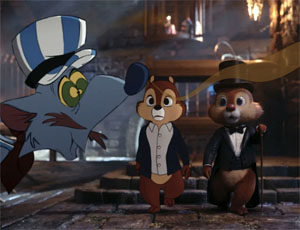 Various investigation, and a capture of the duo by bad guys, eventually leads to a meeting with “Sweet Pete” – the somewhat decrepit, adult version of Peter Pan, who ultimately did grow up, and aged himself out of his Hollywood role. Now Pete gets to decide who is the star in his own studio, and who gets dumped in the trash. The chipmunks endure two encounters with Pete’s “bootleg” machine, a device which dissects toons with lasers and reinstalls new artificial parts to rearrange their features. Dale escapes the first encounter okay, but Chip winds up with one ear that looks like it came from Snoopy. Things get rather complicated, necessitating the assistance of a live female officer from the clay police investigator’s team, who is one of the old show’s biggest fans. A double cross is uncovered, revealing the clay officer to be on the take from Pete. An investigation at the docks unearths Pete’s secret studio for filming the knock offs, and a malfunction of the bootlegging machinery caused by Dale transforms Pete into a CGI replica of Fat Cat. Add to the mix a last-minute assist from Gadget and Zipper (now married?!?!?), and Dale seemingly taking a bullet for Chip, and the culprits are apprehended. Monterey is rescued, though having to undergo some serious surgical reconstruction, as he has been bootlegged into a look-alike to Dumbo. The team is finally reunited at a convention, with anticipation of Dale’s long-awaited series reboot. The film ends with a frustrated Darkwing Duck, alone in another convention booth, attempting to get the viewing audience to chant for a reboot of his own show.
Various investigation, and a capture of the duo by bad guys, eventually leads to a meeting with “Sweet Pete” – the somewhat decrepit, adult version of Peter Pan, who ultimately did grow up, and aged himself out of his Hollywood role. Now Pete gets to decide who is the star in his own studio, and who gets dumped in the trash. The chipmunks endure two encounters with Pete’s “bootleg” machine, a device which dissects toons with lasers and reinstalls new artificial parts to rearrange their features. Dale escapes the first encounter okay, but Chip winds up with one ear that looks like it came from Snoopy. Things get rather complicated, necessitating the assistance of a live female officer from the clay police investigator’s team, who is one of the old show’s biggest fans. A double cross is uncovered, revealing the clay officer to be on the take from Pete. An investigation at the docks unearths Pete’s secret studio for filming the knock offs, and a malfunction of the bootlegging machinery caused by Dale transforms Pete into a CGI replica of Fat Cat. Add to the mix a last-minute assist from Gadget and Zipper (now married?!?!?), and Dale seemingly taking a bullet for Chip, and the culprits are apprehended. Monterey is rescued, though having to undergo some serious surgical reconstruction, as he has been bootlegged into a look-alike to Dumbo. The team is finally reunited at a convention, with anticipation of Dale’s long-awaited series reboot. The film ends with a frustrated Darkwing Duck, alone in another convention booth, attempting to get the viewing audience to chant for a reboot of his own show.
• The entire “Chip ‘n’ Dale Rescue Rangers” is on ok.ru
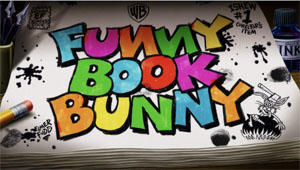 Funny Book Bunny (Warner, Looney Tunes Cartoons, Bugs Bunny, 4/6/23) – Stooped over a drawing board in an art studio, we find a human form with a familiar bulb-shaped head. He turns, to reveal out old friend Elmer Fudd, who has taken up a new sideline for his own pleasure and recreation. For 80 years, he’s never been able to catch that ol’ wabbit. So, why not a switch of venue – from animation, to drawing comic books – where anything can happen, especially if you’re the one drawing it yourself. Elmer figures. in his own comic, he can be the hero and finally win. Thus, his epic title: “Elmer Fudd Kills. Maims, Murderizes, Humiliates, And Utterly Annihiwates Da Wabbit!” Already, he has created panels of sketchy ink outline, where he has Bugs (also drawn in crude, sketchy form) trapped in a cage, pulls Bugs’ fur down to expose his shorts in front of the creatures of the woodland, and even where Elmer gets an appreciative girlfriend. He is about to draw his final panel where he feasts on the wabbit’s flesh, when a phone call from mother summons him away from the drawing board.
Funny Book Bunny (Warner, Looney Tunes Cartoons, Bugs Bunny, 4/6/23) – Stooped over a drawing board in an art studio, we find a human form with a familiar bulb-shaped head. He turns, to reveal out old friend Elmer Fudd, who has taken up a new sideline for his own pleasure and recreation. For 80 years, he’s never been able to catch that ol’ wabbit. So, why not a switch of venue – from animation, to drawing comic books – where anything can happen, especially if you’re the one drawing it yourself. Elmer figures. in his own comic, he can be the hero and finally win. Thus, his epic title: “Elmer Fudd Kills. Maims, Murderizes, Humiliates, And Utterly Annihiwates Da Wabbit!” Already, he has created panels of sketchy ink outline, where he has Bugs (also drawn in crude, sketchy form) trapped in a cage, pulls Bugs’ fur down to expose his shorts in front of the creatures of the woodland, and even where Elmer gets an appreciative girlfriend. He is about to draw his final panel where he feasts on the wabbit’s flesh, when a phone call from mother summons him away from the drawing board.
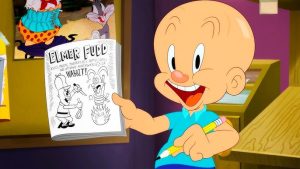 Within one of the panels, where Bugs is found in a simmering pot as Elmer prepares wabbit stew, the doodly Bugs comes to life, and complains about the crick in his neck from having to stand still so long in these panels. Elmer in the frame also comes to life, complaining that Bugs isn’t supposed to be moving around. “So sue me”, responds Bugs. Elmer threatens that “You’re on a one-way ticket to my tum-tum”, his dialogue appearing over his head in a speech balloon. Bugs asks him to repeat that remark again, but as Elmer inhales to speak, Bugs rejuggles the words in the balloon, causing him to utter, “I’m a big stinky dum-dum.” “Your words, not mine”, observes Bugs. Elmer begins to swear in Yosemite Sam style, his words appearing in the balloon as various comic-style typographical symbols, spirals, etc. Bugs cautions him to watch his language – “Kids read these comics, ya know.” Elmer’s temper continues to rise, as he reminds Bugs that this is his comic, where he’s supposed to win. Bugs admits he’s right, and to make it up to him, hands Elmer a “victory speech” to commemorate the occasion – a tiny word balloon reading, “I win”.
Within one of the panels, where Bugs is found in a simmering pot as Elmer prepares wabbit stew, the doodly Bugs comes to life, and complains about the crick in his neck from having to stand still so long in these panels. Elmer in the frame also comes to life, complaining that Bugs isn’t supposed to be moving around. “So sue me”, responds Bugs. Elmer threatens that “You’re on a one-way ticket to my tum-tum”, his dialogue appearing over his head in a speech balloon. Bugs asks him to repeat that remark again, but as Elmer inhales to speak, Bugs rejuggles the words in the balloon, causing him to utter, “I’m a big stinky dum-dum.” “Your words, not mine”, observes Bugs. Elmer begins to swear in Yosemite Sam style, his words appearing in the balloon as various comic-style typographical symbols, spirals, etc. Bugs cautions him to watch his language – “Kids read these comics, ya know.” Elmer’s temper continues to rise, as he reminds Bugs that this is his comic, where he’s supposed to win. Bugs admits he’s right, and to make it up to him, hands Elmer a “victory speech” to commemorate the occasion – a tiny word balloon reading, “I win”.
“Thanks, I guess”, says Elmer, but remarks while holding the balloon that he thought his victory speech would be bigger. Bugs remedies that, by hooking up the balloon to a bicycle pump, and inflating it to several times Elmer’s size. ‘Dat’s more wike it”, says Elmer, oblivious to the fact that the balloon is causing him to float away, out of the comic page and up to a high shelf in the art studio, on which rests a cup of pencils and pens, with a considerably sharp fountain pen sticking out over the edge. The balloon is replaced by a jagged-edged “KA-POP” comic-book sound effect upon striking the pen point, and Elmer falls back to the comic page, to be promptly stabbed into the ground by the falling “KA-POP”
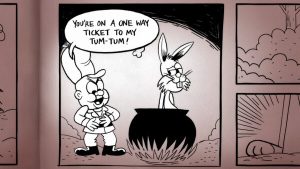 Elmer produces his own jagged-edged stars, which he begins to fling at Bugs like Ninja weapons. Bugs begins running from panel to panel, with Elmer in pursuit, still flinging his weapons. Elmer enters a new frame, and meets up with a close-up of himself already drawn within, having about a dozen sharp stars protruding out of his skin. The giant Elmer tosses the star-slinging Elmer out of frame, warning him to stay in his own panel. Elmer falls onto a page of undrawn panels with just borderline frames – and Bugs lounging on a border drawn at diagonal angle. An ingenious game of Ring-Around-a-Rosy ensues as the characters pursue each other from panel to panel, which fortunately is included in the embedded clip below, so that I don’t have to try to find the words that simply couldn’t describe it. Bugs finally flips a frame like a pivoting window, causing Elmer to fall out of it. Elmer finds his shoelaces are untied, and can’t remember how Mom taught him to tie them. Bugs assists, giving a final pull to the end of the shoelace – and closely approximates a memorable gag from Woody Woodpecker’s “Termites From Mars”, by pulling apart nearly the entire drawing of Elmer into a single line, with which Bugs skips rope. The only portion of Elmer which remains intact are Elmer’s eyes, which roll out of the comic book, onto the desk, and next to a number 2 pencil. The eyeballs hop on top of each other and elongate, assuming the shape of an exclamation point. Then, the topmost eye morphs to assume roughly the shape of an amoeba, grabbing the pencil, and drawing in the rest of Elmer – including two puffs of smoke emitting from his ears in anger. Seizing the pencil, Elmer returns to Bugs’s panel, drawing heavy anvils in place of Bugs’s feet. Then, he redraws himself as a broad-chested superhero. He sends beams of energy from hus eyes, which zap a charred hole in the paper between Bugs’s legs, but also free hum from the anvils. Bugs screams and runs in panic as Super Elmer flies after him through the book – all the way to the unfinished “The End’ panel. Bugs is cornered, and Elmer turns the ereaser end of the pencil toward Bugs, to rub him out of existence entirely. Bugs resorts to the old tactic of distraction, claiming there’s something on Elmer’s chest. Elmer states he won’t fall for such an old gag, but Bugs insists he’s serious, and will point it out for him. Grabbing the pencil, Bugs turns its point to the center of Elmer’s chest – and draws an ugly monster face upon it. Elmer can’t recall drawing an ugly face there – but the face comes to life at this remark, stating, “Who ya’ callin’ ugly?” Taking control of Elmer’s super-body limbs, the Monster socks Elmer’s face, tosses it off his shoulders, then stomps away in a huff. The beheaded Elmer starts crying, at the realization that the wabbit can still trick him, even in his very own comic book. “This ain’t your comic book any more, Mac”, says Bugs, using the pencil to black out most of the image we see. The camera returns to a view of the studio, where the real Elmer finally returns from his phone call with mom. He finds nothing on his drawn pages but spirals and doodles. “Who wuined my comic?” he asks. Suddenly, a flurry of eraser action envelops the shot, and the entire scene except for Elmer’s head is erased to white. The camera pulls further back, and the pencil point enters the frame, to drawing a sketch image of a toilet below Elmer’s head, into which Elmer’s head falls – and is flushed away. The camera pulls further back, to find Bugs, now drawn as we know him, in another art studio, over the pages of his own comic book. He swivels in his chair to address the audience, with a clever play on his classic closing line: “Ain’t I an inker?”
Elmer produces his own jagged-edged stars, which he begins to fling at Bugs like Ninja weapons. Bugs begins running from panel to panel, with Elmer in pursuit, still flinging his weapons. Elmer enters a new frame, and meets up with a close-up of himself already drawn within, having about a dozen sharp stars protruding out of his skin. The giant Elmer tosses the star-slinging Elmer out of frame, warning him to stay in his own panel. Elmer falls onto a page of undrawn panels with just borderline frames – and Bugs lounging on a border drawn at diagonal angle. An ingenious game of Ring-Around-a-Rosy ensues as the characters pursue each other from panel to panel, which fortunately is included in the embedded clip below, so that I don’t have to try to find the words that simply couldn’t describe it. Bugs finally flips a frame like a pivoting window, causing Elmer to fall out of it. Elmer finds his shoelaces are untied, and can’t remember how Mom taught him to tie them. Bugs assists, giving a final pull to the end of the shoelace – and closely approximates a memorable gag from Woody Woodpecker’s “Termites From Mars”, by pulling apart nearly the entire drawing of Elmer into a single line, with which Bugs skips rope. The only portion of Elmer which remains intact are Elmer’s eyes, which roll out of the comic book, onto the desk, and next to a number 2 pencil. The eyeballs hop on top of each other and elongate, assuming the shape of an exclamation point. Then, the topmost eye morphs to assume roughly the shape of an amoeba, grabbing the pencil, and drawing in the rest of Elmer – including two puffs of smoke emitting from his ears in anger. Seizing the pencil, Elmer returns to Bugs’s panel, drawing heavy anvils in place of Bugs’s feet. Then, he redraws himself as a broad-chested superhero. He sends beams of energy from hus eyes, which zap a charred hole in the paper between Bugs’s legs, but also free hum from the anvils. Bugs screams and runs in panic as Super Elmer flies after him through the book – all the way to the unfinished “The End’ panel. Bugs is cornered, and Elmer turns the ereaser end of the pencil toward Bugs, to rub him out of existence entirely. Bugs resorts to the old tactic of distraction, claiming there’s something on Elmer’s chest. Elmer states he won’t fall for such an old gag, but Bugs insists he’s serious, and will point it out for him. Grabbing the pencil, Bugs turns its point to the center of Elmer’s chest – and draws an ugly monster face upon it. Elmer can’t recall drawing an ugly face there – but the face comes to life at this remark, stating, “Who ya’ callin’ ugly?” Taking control of Elmer’s super-body limbs, the Monster socks Elmer’s face, tosses it off his shoulders, then stomps away in a huff. The beheaded Elmer starts crying, at the realization that the wabbit can still trick him, even in his very own comic book. “This ain’t your comic book any more, Mac”, says Bugs, using the pencil to black out most of the image we see. The camera returns to a view of the studio, where the real Elmer finally returns from his phone call with mom. He finds nothing on his drawn pages but spirals and doodles. “Who wuined my comic?” he asks. Suddenly, a flurry of eraser action envelops the shot, and the entire scene except for Elmer’s head is erased to white. The camera pulls further back, and the pencil point enters the frame, to drawing a sketch image of a toilet below Elmer’s head, into which Elmer’s head falls – and is flushed away. The camera pulls further back, to find Bugs, now drawn as we know him, in another art studio, over the pages of his own comic book. He swivels in his chair to address the audience, with a clever play on his classic closing line: “Ain’t I an inker?”
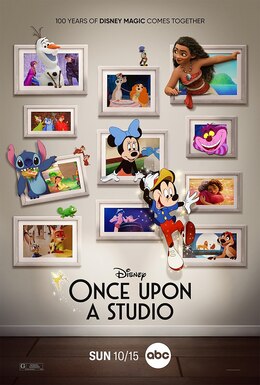 Once Upon a Studio (Disney, 10/13/23) was Disney’s official 100th Anniversary short. On a superficial level, it could be said to be an unabashed exercise in self-promotion – attempting to cram into one short representative cast members from virtually every major Disney animated feature and many of its shorts (with the conscious avoidance of anyone from “Song of the South”, though such characters were not required to be boycotted in Who Framed Roger Rabbit, where Brer Bear and the singing humming birds are notably visible, among others). However, the film is done well, as something of a labor of love, and features some creative crossovers for characters who have never formally met to interact – plus a sentimental moment between Mickey and his creator (if we don’t buy into Ub Iwerks really deserving the credit).
Once Upon a Studio (Disney, 10/13/23) was Disney’s official 100th Anniversary short. On a superficial level, it could be said to be an unabashed exercise in self-promotion – attempting to cram into one short representative cast members from virtually every major Disney animated feature and many of its shorts (with the conscious avoidance of anyone from “Song of the South”, though such characters were not required to be boycotted in Who Framed Roger Rabbit, where Brer Bear and the singing humming birds are notably visible, among others). However, the film is done well, as something of a labor of love, and features some creative crossovers for characters who have never formally met to interact – plus a sentimental moment between Mickey and his creator (if we don’t buy into Ub Iwerks really deserving the credit).
Our scene opens in live-action at the Disney animation building at their campus in Burbank. The film begins possibly on its worst-foot forward, with an unknown female among the last to exit the studio doors at the end of the work day, gushing with overacted enthusiasm about it being the 100th anniversary of Disney animation. She could really have used an acting coach, as she sounds like a tour guide on a bad day for the Jungle Cruise. She is accompanied by Burny Mattinson, then Disney’s longest-tenured employee, who died shortly after the filming. Burny states, “If these walls could talk…” (However, if these walls COULD talk, we’d probably only get an abbreviated story – as the building front they are exiting was only constructed, if I recall, during approximately the time period covered by this article. Was the new front attached to older buildings that had been around during the studio’s heyday? Anyone with info may wish to let us know – but I somehow doubt that the particular walls being addressed would have had much to say that would have gone back to Walt’s day.
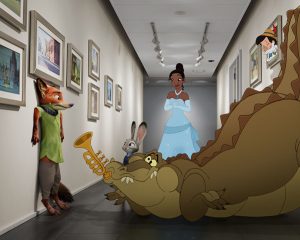 Anyway, once the doors are locked tight, the camera pans over to some framed historic artwork on the lobby wall, featuring what appears to be a cel setup from “Mickey’s Birthday Party.” There is a history error at the outset, in that the image depicts Mickey and Minnie with traditional ears – when in fact, the original cartoon was produced during the experimental period when Mickey’s ears had shaded recesses in them for hearing (much like Jerry Mouse’s), and moved in perspective. However, it seems that the choice to commit this error was intentional for the sake of style. A modern Mickey with whites to his eyes was desired, and there simply weren’t a great lot of appearances in past films where the white-eyed Mickey and Minnie appeared together in appealing costumes in which the perspective ears weren’t present – virtually the only one being a Nabisco short produced for the New York World’s Fair, “Mickey’s Surprise Party”, which until recent years was virtually unknown to Disney fandom. So, the compromise was made of wardrobe and set from “Mickey’s Birthday Party”, but with the old-fashioned ears. It just looked better. All of a sudden, Mickey springs to life, and whispers for Tinker Bell. Tink appears, and with a nod of her head answers Mickey’s inquiry as to whether the staff is all gone. Mickey and Minnie pop out of the picture, and proceed to round up “The Gang”. The intention? To gather all the old cast members in the courtyard for a 100th anniversary group photo.
Anyway, once the doors are locked tight, the camera pans over to some framed historic artwork on the lobby wall, featuring what appears to be a cel setup from “Mickey’s Birthday Party.” There is a history error at the outset, in that the image depicts Mickey and Minnie with traditional ears – when in fact, the original cartoon was produced during the experimental period when Mickey’s ears had shaded recesses in them for hearing (much like Jerry Mouse’s), and moved in perspective. However, it seems that the choice to commit this error was intentional for the sake of style. A modern Mickey with whites to his eyes was desired, and there simply weren’t a great lot of appearances in past films where the white-eyed Mickey and Minnie appeared together in appealing costumes in which the perspective ears weren’t present – virtually the only one being a Nabisco short produced for the New York World’s Fair, “Mickey’s Surprise Party”, which until recent years was virtually unknown to Disney fandom. So, the compromise was made of wardrobe and set from “Mickey’s Birthday Party”, but with the old-fashioned ears. It just looked better. All of a sudden, Mickey springs to life, and whispers for Tinker Bell. Tink appears, and with a nod of her head answers Mickey’s inquiry as to whether the staff is all gone. Mickey and Minnie pop out of the picture, and proceed to round up “The Gang”. The intention? To gather all the old cast members in the courtyard for a 100th anniversary group photo.
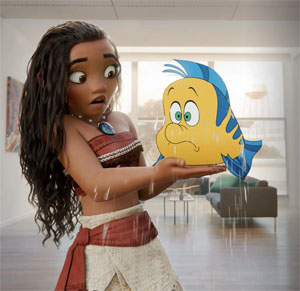 Classic characters begin springing out of artwork right and left. Some of the interactions are memorable. Moana winds up with Flounder in her arms, asking for water. She asks Merlin (who seems to be serving tea to several characters) for a little help, and Merlin produces water inside the inverted hat of the Mad Hatter. Flounder is inserted, prompting the Hatter to ad lib, “Waiter! There’s a carp in my cap.” Stromboli is seen throwing a temper tantrum at a live-action vending machine that refuses to dispense paid-for goodies. Gaston, along with several Disney villains, preens himself before a restroom mirror, but has his garishly-handsome smile marred by the appearing eyes and teeth of the Cheshire Cat. Pooh can’t get out of his framed image, as he is still stuck in the entrance to Rabbit’s front door, with the cast in the corridor trying to tug him out. The original 15 Dalmatian puppies are gathered around a big-screen TV, watching the “Night on Bald Mountain” sequence from Fantasia, while one of the passing cast members from “Frozen” tells them to come on, or they’ll get nightmares. The devil-bat character from the film emerges partway from the video image, sending the pups scrambling. They collide with Uncle Scrooge and carry him away, knocking from his hands two large money sacks. Down from the ceiling jump Robin Hood and Little John, to carry the sacks away while remarking to each other “Oo De Lally!” Donald Duck is having trouble getting downstairs, as a crowded elevator is being held up waiting for the sloth from Zootopia to board. When he finally does, along comes Baymax from “Big Hero 6″, forcing his inflatable way into the elevator too and almost smothering Donald. Kaa is up to his old tricks, trying to hypnotize Clarabelle Cow – but Rapunzel is right behind, wielding her trusty frying pan as a weapon, stating, “Don’t worry, Mickey. I’ve got this”, and letting Kaa have it out of frame, as we see only the coils of Kaa’s tail going limp.
Classic characters begin springing out of artwork right and left. Some of the interactions are memorable. Moana winds up with Flounder in her arms, asking for water. She asks Merlin (who seems to be serving tea to several characters) for a little help, and Merlin produces water inside the inverted hat of the Mad Hatter. Flounder is inserted, prompting the Hatter to ad lib, “Waiter! There’s a carp in my cap.” Stromboli is seen throwing a temper tantrum at a live-action vending machine that refuses to dispense paid-for goodies. Gaston, along with several Disney villains, preens himself before a restroom mirror, but has his garishly-handsome smile marred by the appearing eyes and teeth of the Cheshire Cat. Pooh can’t get out of his framed image, as he is still stuck in the entrance to Rabbit’s front door, with the cast in the corridor trying to tug him out. The original 15 Dalmatian puppies are gathered around a big-screen TV, watching the “Night on Bald Mountain” sequence from Fantasia, while one of the passing cast members from “Frozen” tells them to come on, or they’ll get nightmares. The devil-bat character from the film emerges partway from the video image, sending the pups scrambling. They collide with Uncle Scrooge and carry him away, knocking from his hands two large money sacks. Down from the ceiling jump Robin Hood and Little John, to carry the sacks away while remarking to each other “Oo De Lally!” Donald Duck is having trouble getting downstairs, as a crowded elevator is being held up waiting for the sloth from Zootopia to board. When he finally does, along comes Baymax from “Big Hero 6″, forcing his inflatable way into the elevator too and almost smothering Donald. Kaa is up to his old tricks, trying to hypnotize Clarabelle Cow – but Rapunzel is right behind, wielding her trusty frying pan as a weapon, stating, “Don’t worry, Mickey. I’ve got this”, and letting Kaa have it out of frame, as we see only the coils of Kaa’s tail going limp.
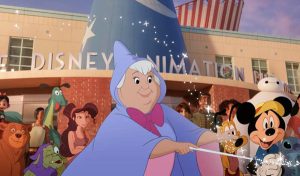 Mickey pauses in a corridor for a fond, thoughtful look at the portrait of Walt. He removes his hat reverently and smiles. The voice of Minnie is heard offscreen calling him, and Mickey, in a whisper, speaks to the portrait. ‘Gotta go – – but thanks. On with the show,” Everyone gathers in the courtyard. Wreck-It Ralph slams into the glass front door, though taking the blow instead of breaking through. When Mickey asks him if he’s all right, the staggering Ralph remarks in mistaken identity, “Never better, Garfield!” Goofy mounts a tall ladder with an old-fashioned 1930’s camera, and tries to find a timer button. The ladder wobbles, topples, and the camera is busted – with Stitch briefly seen trying to eat the fallen photographic plate. “Well, that was fun”, remarks Grumpy sarcastically, turning away to begin walking back into the studio. Equally gloomy Eeyore remarks, “Maybe we can try again – in another 100 years.” It seems the project has failed – but just as everyone is about to go back to their walls, the strums of a lute are heard from Alan-a-Dale, resting within the “O” of the “Animation” sign above them – playing, “When You Wish Upon a Star”. Other characters begin to chime in, wuth Scat Cat joining instrumentally on cornet, followed by Beauty and the Beast vocally. Hades puts his hand to his head, stating he knew this was going to happen. Soon everyone seems to be singing, including several Disney princesses together, Pooh and Tigger, and of course Jiminy Crickey. Meanwhile, the brooms from Fantasia sweep together the broken pieces of the camera, while Fix-Ut Felix magically reassembles it with his trusty hammer, and Hercules rights the ladder for Goofy. The Fairy Godmother magically floats Goofy up to set the camera and timer in place atop the ladder, and the film shot pulls back to an ultra-wide view, with flash provided by Tinker Bell, for the the final group shot representing the official picture taken, and the fade-out.
Mickey pauses in a corridor for a fond, thoughtful look at the portrait of Walt. He removes his hat reverently and smiles. The voice of Minnie is heard offscreen calling him, and Mickey, in a whisper, speaks to the portrait. ‘Gotta go – – but thanks. On with the show,” Everyone gathers in the courtyard. Wreck-It Ralph slams into the glass front door, though taking the blow instead of breaking through. When Mickey asks him if he’s all right, the staggering Ralph remarks in mistaken identity, “Never better, Garfield!” Goofy mounts a tall ladder with an old-fashioned 1930’s camera, and tries to find a timer button. The ladder wobbles, topples, and the camera is busted – with Stitch briefly seen trying to eat the fallen photographic plate. “Well, that was fun”, remarks Grumpy sarcastically, turning away to begin walking back into the studio. Equally gloomy Eeyore remarks, “Maybe we can try again – in another 100 years.” It seems the project has failed – but just as everyone is about to go back to their walls, the strums of a lute are heard from Alan-a-Dale, resting within the “O” of the “Animation” sign above them – playing, “When You Wish Upon a Star”. Other characters begin to chime in, wuth Scat Cat joining instrumentally on cornet, followed by Beauty and the Beast vocally. Hades puts his hand to his head, stating he knew this was going to happen. Soon everyone seems to be singing, including several Disney princesses together, Pooh and Tigger, and of course Jiminy Crickey. Meanwhile, the brooms from Fantasia sweep together the broken pieces of the camera, while Fix-Ut Felix magically reassembles it with his trusty hammer, and Hercules rights the ladder for Goofy. The Fairy Godmother magically floats Goofy up to set the camera and timer in place atop the ladder, and the film shot pulls back to an ultra-wide view, with flash provided by Tinker Bell, for the the final group shot representing the official picture taken, and the fade-out.
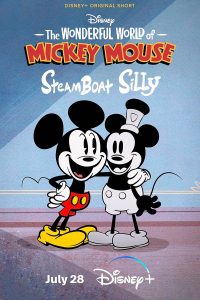 The irreverant supervising director Paul Rudish and director Eddie Trigueros had their own idea of a 100th Anniversary short, and thus directed for the small screen Steamboat Silly (Disney (TV), 7/28/23). It’s a nostalgia party for Mickey and his friends, Minnie, Donald, Goofy, and Daisy. Mickey has found an old crate of memorabilia in the attic, including his old bandmaster suit from The Band Concert, his Sorcerer’s Apprentice hat, and his contact lenses (giving him whites to his eyes). To suit the mood, he’s dragged down a tall stack of film cans from his private vault, to show his old home movies. Donald tries to walk out, but is dragged back in by Daisy. Mickey threads up the projector with a print of Steamboat Willie – but the print breaks halfway through. Mickey holds up a piece of the broken film, where a frame has snapped in half – and one of the images of Mickey at the ship’s wheel dangles from the frame with no footing. The miniature Mickey falls out of the film, bounces as a black dot on the ground, then springs up, fully life-size, but still in black and white, with a noticeable continuing flicker to his light exposure. The two versions of Mickey survey each other, matching each other’s motion, while the rest of those in the room react in shock. Real Mickey thinks this is the coolest thing ever, and as film Mickey starts to hoof a little tap move, Mickey interprets him as communicating that he wants a film song to shimmy along. Mickey begins whistling a spritely tune, and Film Mickey begins dancing – all over the place – including atop the mantel, kicking down several framed portraits and vases, and on the couch, which he breaks in half. Mickey joins his counterpart in dancing, but jostles over the projector table with his hip. The broken film reel falls, landing upon the blade of a tipped whirling table fan. The rapidly-spinning reel begins to eject more miniature Mickeys from its frames, tossing them onto the floor one-by-one, where they each become life-sized and begin dancing. Each of the new Film Mickeys hop out the window in single-file, and form a parade tap-dancing their way toward town. Aghast Goofy attempts to warn Mickey of this development, but is interrupted as one of the Film Mickeys opens Goofy’s mouth, and begins playing his teeth like a xylophone, lifting a gag from the original cartoon. Donald’s warning is likewise interrupted, as another Film Mickey grabs his neck, and stretches it to perform music just like the goose used in the original production. Only Minnie gets the word to Mickey of the advancing stampede heading toward town. Mickey assures her that everything is under control, and he’ll round the bunch up. The gang is not so sure as he darts down the road, and Minnie observes, “He’s gonna need our help.”
The irreverant supervising director Paul Rudish and director Eddie Trigueros had their own idea of a 100th Anniversary short, and thus directed for the small screen Steamboat Silly (Disney (TV), 7/28/23). It’s a nostalgia party for Mickey and his friends, Minnie, Donald, Goofy, and Daisy. Mickey has found an old crate of memorabilia in the attic, including his old bandmaster suit from The Band Concert, his Sorcerer’s Apprentice hat, and his contact lenses (giving him whites to his eyes). To suit the mood, he’s dragged down a tall stack of film cans from his private vault, to show his old home movies. Donald tries to walk out, but is dragged back in by Daisy. Mickey threads up the projector with a print of Steamboat Willie – but the print breaks halfway through. Mickey holds up a piece of the broken film, where a frame has snapped in half – and one of the images of Mickey at the ship’s wheel dangles from the frame with no footing. The miniature Mickey falls out of the film, bounces as a black dot on the ground, then springs up, fully life-size, but still in black and white, with a noticeable continuing flicker to his light exposure. The two versions of Mickey survey each other, matching each other’s motion, while the rest of those in the room react in shock. Real Mickey thinks this is the coolest thing ever, and as film Mickey starts to hoof a little tap move, Mickey interprets him as communicating that he wants a film song to shimmy along. Mickey begins whistling a spritely tune, and Film Mickey begins dancing – all over the place – including atop the mantel, kicking down several framed portraits and vases, and on the couch, which he breaks in half. Mickey joins his counterpart in dancing, but jostles over the projector table with his hip. The broken film reel falls, landing upon the blade of a tipped whirling table fan. The rapidly-spinning reel begins to eject more miniature Mickeys from its frames, tossing them onto the floor one-by-one, where they each become life-sized and begin dancing. Each of the new Film Mickeys hop out the window in single-file, and form a parade tap-dancing their way toward town. Aghast Goofy attempts to warn Mickey of this development, but is interrupted as one of the Film Mickeys opens Goofy’s mouth, and begins playing his teeth like a xylophone, lifting a gag from the original cartoon. Donald’s warning is likewise interrupted, as another Film Mickey grabs his neck, and stretches it to perform music just like the goose used in the original production. Only Minnie gets the word to Mickey of the advancing stampede heading toward town. Mickey assures her that everything is under control, and he’ll round the bunch up. The gang is not so sure as he darts down the road, and Minnie observes, “He’s gonna need our help.”
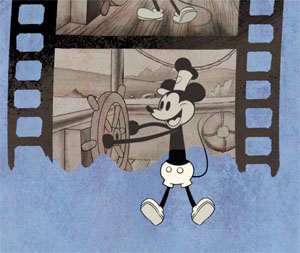 In town, the mice number into the hundreds, if not thousands. They invade venue after venue, playing the hair on patrons in a barber shop like violins. Tap-dancing in a surgery room until the patient’s organs appear with faces on them, dancing on the patient’s chest. Invading a ballet class, where the dancers’ skeletons are induced to pop out of their bodies, and join the Mickeys in a reprise of Iwerks’ The Skeleton Dance. Encircling a close-up of Dumbo like the Pink Elephants On Parade. Mickey gets to be as bad as the rest of them, found with the group, swinging Black Pete around by the tail. Mickey still thinks things are all good, until a mushroom cloud explodes on Main Street, and a car full of Mickeys careens out of control, bringing down a lamppost covered in more Mickeys. Mickey finally begs the gang to help round these revelers up. Everyone chases a group of Mickeys. Minnie follows several into a laundromat, but is interfered with by dancing clothes emerging from the dryers. Daisy follows one off the end of a steeply-descending staircase, the wire-limbed mouse extending its legs to stay at a level height, while Daisy falls flat on her beak between rows of Mickeys who line the staircase as if it were a production number. Donald’s chase is disrupted by other mice jumping up and down on the background, bending the road into rising and descending curves that closely resemble the work of rival animators Hugh Harman and Rudolf Ising in You Don’t Know What You’re Doin’. Goofy has finally caught one, but Donald slams into him, launching Goofy upwards into an apartment window, where the Goof gets lodged in the middle of the keyboard area of an upright piano. A Film Mickey comes along, and stretches Goofy’s jaw to expose his teeth in place of the dislodged keyboard, playing a tune of Goofy’s choppers. Mickey himself pursues another of his duplicates, who disappears down a street manhole, and below ground turns a water valve with a quick twist as if spinning the wheel of the original steamboat. Mickey and all his gang rise from the street on fountains of water, and are jetted into the windows of a music supply house. They all wind up on the ground floor, caught within various stock musical instruments, Mickey himself rising with a piccolo stuck upon his nose. But Mickey gets an idea from this occurrence. Perhaps if they were to change the mice’s tune…
In town, the mice number into the hundreds, if not thousands. They invade venue after venue, playing the hair on patrons in a barber shop like violins. Tap-dancing in a surgery room until the patient’s organs appear with faces on them, dancing on the patient’s chest. Invading a ballet class, where the dancers’ skeletons are induced to pop out of their bodies, and join the Mickeys in a reprise of Iwerks’ The Skeleton Dance. Encircling a close-up of Dumbo like the Pink Elephants On Parade. Mickey gets to be as bad as the rest of them, found with the group, swinging Black Pete around by the tail. Mickey still thinks things are all good, until a mushroom cloud explodes on Main Street, and a car full of Mickeys careens out of control, bringing down a lamppost covered in more Mickeys. Mickey finally begs the gang to help round these revelers up. Everyone chases a group of Mickeys. Minnie follows several into a laundromat, but is interfered with by dancing clothes emerging from the dryers. Daisy follows one off the end of a steeply-descending staircase, the wire-limbed mouse extending its legs to stay at a level height, while Daisy falls flat on her beak between rows of Mickeys who line the staircase as if it were a production number. Donald’s chase is disrupted by other mice jumping up and down on the background, bending the road into rising and descending curves that closely resemble the work of rival animators Hugh Harman and Rudolf Ising in You Don’t Know What You’re Doin’. Goofy has finally caught one, but Donald slams into him, launching Goofy upwards into an apartment window, where the Goof gets lodged in the middle of the keyboard area of an upright piano. A Film Mickey comes along, and stretches Goofy’s jaw to expose his teeth in place of the dislodged keyboard, playing a tune of Goofy’s choppers. Mickey himself pursues another of his duplicates, who disappears down a street manhole, and below ground turns a water valve with a quick twist as if spinning the wheel of the original steamboat. Mickey and all his gang rise from the street on fountains of water, and are jetted into the windows of a music supply house. They all wind up on the ground floor, caught within various stock musical instruments, Mickey himself rising with a piccolo stuck upon his nose. But Mickey gets an idea from this occurrence. Perhaps if they were to change the mice’s tune…
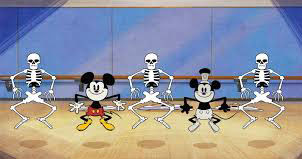 We cut to the building’s exterior, where Minnie and Daisy emerge, bearing herald’s trumpets, each with a banner bearing the large letters “MM”. They blow a very familiar fanfare, as Donald appears, marching and beating a snare drum, and Goofy marches with the instruments of a one-man band. Finally, Mickey appears, in trim, red bandmaster’s outfit and waving a baton. Yes, it’s a full-blown rendition of The Mickey Mouse Club March! The Film Mickeys instantly take notice, abandoning what they are doing to fall in line for a paade through the streets. Several shots of the classic series opening are directly homaged, including the trampoline bit near the end of the song, as Mickey leads the parade back to his home and outside the living room window. One by one, the Film Mice jump upon the trampoline, and are tossed by the gang into the open window, where they land back in the open side-panel of the projector. The projector door is soon so full, various hands, feet, and tails of the mice are bunched up within it in a log jam, and Mickey has to push and shove to force the last of them inside, and slam the projector door shut. The situation is finally under control (except for the unresolved and not-discussed matter of who will pay for the city’s damages). Mickey’s had enough of nostalgia for one day, and attempts to carry the rest of the film cans back to the vault. But the stack topples in his arms, and film can after film can springs open – revealing a myriad of emerging classic Mickeys from the past, including Plane Mickey, Two Gun Mickey, The Band Concert’s whirlwind, Thru the Mirror Mickey dancing with cards as peacock plumes, Clock Cleaners shimmying Mickey, Lonesome Ghosts detective Mickey, Sorcerer’s Apprentice Mickey, Nifty Nineties Mickey in old-time garb, dancing Mickey from his Birthday Party, Mickey ascending a beanstalk, and Prince and Pauper Mickeys. Mickey can only react in sheepish embarrassment at this new room full of Mickeys, but Minnie finally resigns herself to the situation. “The more Mickey, the more wonderful the world”, she observes. Mickey holds her hand, as the roof of the house pops open, spewing Mickeys into the stratosphere. The final shot is from outer space, as the whole globe turns, becoming a giant smiling face of Mickey, which winks at us and laughs as a curtain closes over the show, reading “The End”.
We cut to the building’s exterior, where Minnie and Daisy emerge, bearing herald’s trumpets, each with a banner bearing the large letters “MM”. They blow a very familiar fanfare, as Donald appears, marching and beating a snare drum, and Goofy marches with the instruments of a one-man band. Finally, Mickey appears, in trim, red bandmaster’s outfit and waving a baton. Yes, it’s a full-blown rendition of The Mickey Mouse Club March! The Film Mickeys instantly take notice, abandoning what they are doing to fall in line for a paade through the streets. Several shots of the classic series opening are directly homaged, including the trampoline bit near the end of the song, as Mickey leads the parade back to his home and outside the living room window. One by one, the Film Mice jump upon the trampoline, and are tossed by the gang into the open window, where they land back in the open side-panel of the projector. The projector door is soon so full, various hands, feet, and tails of the mice are bunched up within it in a log jam, and Mickey has to push and shove to force the last of them inside, and slam the projector door shut. The situation is finally under control (except for the unresolved and not-discussed matter of who will pay for the city’s damages). Mickey’s had enough of nostalgia for one day, and attempts to carry the rest of the film cans back to the vault. But the stack topples in his arms, and film can after film can springs open – revealing a myriad of emerging classic Mickeys from the past, including Plane Mickey, Two Gun Mickey, The Band Concert’s whirlwind, Thru the Mirror Mickey dancing with cards as peacock plumes, Clock Cleaners shimmying Mickey, Lonesome Ghosts detective Mickey, Sorcerer’s Apprentice Mickey, Nifty Nineties Mickey in old-time garb, dancing Mickey from his Birthday Party, Mickey ascending a beanstalk, and Prince and Pauper Mickeys. Mickey can only react in sheepish embarrassment at this new room full of Mickeys, but Minnie finally resigns herself to the situation. “The more Mickey, the more wonderful the world”, she observes. Mickey holds her hand, as the roof of the house pops open, spewing Mickeys into the stratosphere. The final shot is from outer space, as the whole globe turns, becoming a giant smiling face of Mickey, which winks at us and laughs as a curtain closes over the show, reading “The End”.
• A strange version of the short, filmed off a screen, but with added narration as if from a Disney storyteller album, is embedded below. It’s worth it to see the full visuals and creative references to the past included in this memorable film.
There seems no more appropriate way to close this series of posts except Porky Pig’s classic line, “Th-th-That’s All, Folks.” But is it? No doubt, future animators will have their own something to say in poking fun or attention at their own industry. So perhaps it’s best to tweak the line a bit, to read, “Th-th-That’s All, Folks – – for now.”